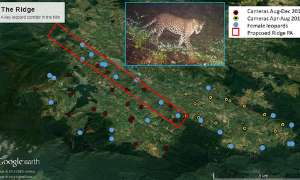
Feb 23 2021.
views 474The Central Highlands is home to many leopards who unfortunately have been threatened by human activities. In 2020 Sri Lanka lost 13 of its leopards this way. Upon identifying a significant leopard population along an 18km long corridor between Castlereagh and Maussakelle Reservoirs, the Wilderness and Wildlife Conservation Trust (WWCT) has joined hands with several plantation companies to protect this sensitive ecosystem. The Corridor spans from Kew Estate in the Southeast to the Ballapenumgala Forest Reserve in the northwest and connects to the Peak Wilderness Forest Reserve.

The aims of this collaboration are to safeguard the corridor in the interest of biodiversity and wildlife conservation, to increase the connectivity function at Peak Ridge Corridor while raising awareness and promoting wildlife conservation among local communities, tea estates throughout Sri Lanka. The collaboration, therefore, makes it Sri Lanka’s first private protected area which will provide a blueprint for future conservation projects in Sri Lanka.
“This is a landmark collaborative initiative where multiple actors are coming together to create this,” opined WWCT cofounder Anjali Watson. “We observe resident leopards and reproduction patterns among leopards in this landscape. At one point there were five different litters and that is a positive sign of this landscape. The prey base is also there in its surrounds and around 85% is natural prey. This result shows that often tea estates communities complain about dogs being taken when there are cubs in the landscape that is when everyone should know and try keeping their dogs secure. This is when the female will go for something small that she can take.

Pictured: Anjali Watson
There is enough other wildlife along this stretch and that is something that needs to be celebrated. There are good quality habitats and the in-between places which aren’t very good and we want to target each of these places to restore them and improve the habitat. These are like stepping stones for these animals and they use good areas of forest to move. If the companies and estates are able to improve those areas it would be a huge boost for this ridge.”
“By targeting the leopard we can conserve biodiversity in the area,” opined Dr. Andrew Kittle. “Therefore there can be continued biodiversity monitoring across estates and the completion of comparative databases. There are other species such as the fishing cat, butterflies, frogs which are endemic to these areas.

Pictured: Dr Andrew Kittle
Another concern is habitat fragmentation and Dr Kittle and Watson said that it’s important to ensure that existing forest patches aren’t compromised. “Collective mapping and identifying forest patches is a must. There’s a patch of land that needs to be forested and the establishment of the Peak Ridge Forest Corridor has addressed it. Since we do not have the luxury of moving in for virgin forest, marrying these concepts together will help achieve overall landscape conservation. It is also important to promote human-wildlife coexistence. Animals are moving outside protected areas as well. Therefore we need to address issues that come upfront, conduct on-ground anti-snare programmes and device solutions for potential problems when they arise.”
Several short term, medium and long term solutions were also mentioned. “In the short term, there will be a reduction in snaring along the corridor and wider areas. Medium-term solutions include engagement and positive feedback from certain communities. In the long term, there could be improved ridge-line habitat, improved biodiversity and watershed sensitivity. However, it has also been observed that habitats are shrinking for the leopards. Therefore the need to restore forest patches is quite important.”
This initiative therefore will establish Peak Ridge Corridor as a Peak Ridge Forest Corridor. The companies that joined hands for this collaboration include MJF Tea Gardens Pvt. Ltd., Kelaniya and Braemar Estate Pvt., Ltd., Bogawantalawa Tea Estates PLC, Madulsima Plantations PLC, Horana Plantations PLC, Resplendent Ceylon Pvt. Ltd., Dilmah Conservation and Biodiversity Sri Lanka.
0 Comments